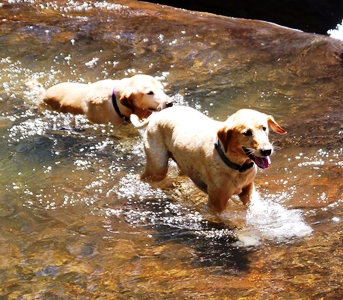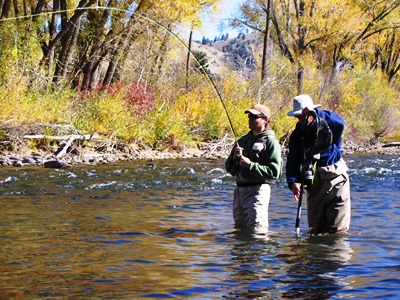Think about your favorite stream or river. It could be a neighborhood creek that your kids and dog love to splash through every time you go for a walk. It could be a wide stream where you cast your line on a cool morning to see if you can fool a fish into biting. It could be a slow-flowing river where you gather with friends for an annual kayak trip.
Are these streams and rivers clean enough for you to fish from, splash through, and float on?
The alarming answer is that for the most part, no one knows.
The information we do have reveals serious water pollution problems across the United States. And what we know about this problem is based on states monitoring just a fraction of the streams and rivers nationwide. The vast majority of streams are not regularly tested — or even tested at all.
In April, the Izaak Walton League released a new report, "Clean Water: Your Right To Know." This report is the first to comprehensively assess whether the American people have access to timely, accurate, and local information about water quality in streams and rivers across the country. Some of these waters are healthy and teaming with life. Others are filled with bacteria, carcinogens, and excess nutrient runoff. Yet for the majority of America’s streams and rivers, there is little timely information about water quality.
The Izaak Walton League believes that every American has the right to know — not only about the health of their waters but how well states are identifying and addressing water pollution problems.
Changing Nature of Water Pollution
Thanks to the federal Clean Water Act and associated state laws, pollution from "point sources" — such as factory pipes or sewage treatment plants — is closely regulated, and discharges are treated to reduce the most harmful impacts. Although few people would say that pollution from point sources has been solved, there is a well-established system in place to permit, reduce, and treat these discharges and closely track pollution sources.
But there are many other sources of water pollution, including sources that are much more difficult to pinpoint.
There is widespread agreement that the greatest threat to water quality today is polluted runoff. Water that runs off our yards, roads, and farm fields carries a laundry list of pollutants into streams and rivers across the country: bacteria and pathogens; nutrient-rich fertilizers and pesticides; oil, antifreeze, and other chemicals; and heavy metals and acid mine drainage.
This runoff is flowing untreated into the streams and rivers that are the lifeblood of an interconnected system of waterways nationwide. Neither the Clean Water Act nor most state laws effectively address this problem — or address it all.
Because polluted runoff is the most pressing problem today, it is even more important that streams and rivers be systematically and consistently monitored at more — not fewer — local sites.
Not Enough Information
 With today’s technology, we can access information about almost any issue instantaneously. People expect to have accurate and timely information about issues important to them — everything from the weather to their commute to the latest box scores and news.
With today’s technology, we can access information about almost any issue instantaneously. People expect to have accurate and timely information about issues important to them — everything from the weather to their commute to the latest box scores and news.
It’s the same for critical conservation issues. For example, people have access to daily reports about air quality, allowing them to make critical decisions to protect their health. Having information about water quality in local streams and rivers is just as important.
Yet up-to-date information about water quality in streams across America is nearly impossible to find. The Izaak Walton League wanted to understand why: Why doesn’t the public have ready access to up-to-date water quality information? Is water quality being tested frequently enough to alert local residents — and government agencies — to potential problems? Are drinking water supplies at risk — and more expensive to treat because the streams flowing into them do not meet state water quality standards?
The League spent more than six months researching these issues. Our report presents the results, including alarming information about the lack of reliable water quality information — and a few good-news stories about states that are working effectively with volunteers to expand the number of streams and rivers tested and the amount of timely information available to citizens.
Troubling Picture
The League conducted an extensive investigation into water quality monitoring practices and water pollution problems in all 50 states, developed a grading system to compare the states, and uncovered startling results.
- Dirty Waters: Based on state reports to the U.S. Environmental Protection Agency (U.S. EPA), more than half (55%) of the streams and rivers tested were not safe for uses designated by the states such as swimming, fishing, and as sources of drinking water. The pollutants in these waterways include a laundry list of bacteria, carcinogens, and nutrients.
- Numbers Don’t Add Up: U.S. EPA reports that nationwide, 31% of streams and rivers are monitored for water quality. However, based on our calculations, states are effectively testing and tracking water quality in just 2% of rivers and streams. Moreover, many states seriously mislead the public about the percentage of waters they actually test.
- Out-of-Date Information: Publicly available information about water quality is often 5 to 10 years old, so citizens have no idea what’s in their neighborhood streams today. This isn’t a problem just at the state level but nationally as well. In March 2016, U.S. EPA released its 2008-2009 National Rivers and Streams Assessment, which is not only out of date but is based on a very limited number of water quality tests conducted randomly across the country.
- Lack of Local Information: U.S. EPA recommends regular water quality monitoring at multiple sites on a stream. However, many states conduct tests only at the mouths of major rivers and streams and randomly scatter a limited number of other test sites across the state. This leaves most Americans in the dark about water quality in their neighborhoods and makes it almost impossible to pinpoint sources of pollution problems.
- Weak Water Quality Standards: Many states have weak water quality standards that could inflate the number of waters rated clean and healthy — and they don’t monitor water quality often enough to make accurate safety claims about streams and rivers statewide.
- Failure to Leverage Volunteer Resources: A majority of states don’t work proactively with volunteer stream monitors or effectively use the data volunteers collect to ensure the public has accurate, timely, and site-specific information about water quality.
Based on these results, the majority of states (26) receive a D or an F for how effectively they monitor water quality in streams and rivers and engage volunteers.
Misguided Monitoring
The Clean Water Act requires states to monitor the safety of all waterways and report that information publicly every two years. When problems are discovered, states are required to address them with clean-up and restoration efforts. However, it’s left up to each state to decide how to monitor its waterways and determine what’s "polluted."
 States vary widely in virtually every aspect of water quality monitoring and assessment, including setting standards used to assess water quality; where, when, and which waters are tested; the types of tests performed; and how information is provided to the public.
States vary widely in virtually every aspect of water quality monitoring and assessment, including setting standards used to assess water quality; where, when, and which waters are tested; the types of tests performed; and how information is provided to the public.
Many states take a scattershot approach to monitoring water quality, testing just a small fraction of the streams and rivers across the state. Not only do some states consider this a job well done, U.S. EPA actually encourages states to monitor randomly selected sites and use that information as an assessment of all the state’s rivers and streams.
Although this random sampling may provide some basic information about water quality, it falls short of effectively pinpointing pollution problems and their sources. Moreover, it opens the possibility that many more serious threats to human health and to fish and wildlife remain undetected in our waters. Some state officials agree, stating that information on the condition of specific waters is "more essential to state programs for managing water quality than the kind of general information provided by statistical designs."
The problem isn’t simply how or when monitoring is conducted — it’s the fact that U.S. EPA and states are not transparent with the results they present to the public.
U.S. EPA’s ATTAINS database is where state-reported data can be accessed by the public. If the average citizen visits this site, they’d likely come away with the impression that their state is effectively monitoring water pollution in streams and rivers. That person would have no idea that even the small number of streams and rivers that are monitored are not sampled regularly, or that weak water quality standards can artificially inflate the number of waterways considered clean and safe.
Solving These Problems with Citizen Science
The problems are serious — and solvable. The solution is empowering more Americans to collect scientifically valid water quality data and ensuring states use this data more effectively.
 In communities nationwide, individuals and groups are collecting high-quality, reliable water quality data. A few states are good partners with citizen volunteers. However, a majority of states (29) get Ds and Fs for volunteer engagement because they do not work proactively with volunteers or effectively utilize the data volunteers collect. Every state needs to expand its use of volunteer data and support for volunteer monitors to ensure the public has accurate, timely, and site-specific information about water quality.
In communities nationwide, individuals and groups are collecting high-quality, reliable water quality data. A few states are good partners with citizen volunteers. However, a majority of states (29) get Ds and Fs for volunteer engagement because they do not work proactively with volunteers or effectively utilize the data volunteers collect. Every state needs to expand its use of volunteer data and support for volunteer monitors to ensure the public has accurate, timely, and site-specific information about water quality.
The Izaak Walton League has trained and supported volunteers for decades through our Save Our Streams (SOS) program — one of the first nationwide programs for citizen stream monitors. Variations of Save Our Streams have been adopted by states and volunteer groups across the country.
Today, we have an opportunity. An opportunity to:
- Dramatically increase the number of streams and rivers monitored for water quality every year.
- Ensure Americans have up-to-date information about water quality in their communities.
- Expand state engagement with volunteer monitors and ensure states more effectively use the water quality data volunteers collect.
- Follow the roadmap provided by some of the most successful states and volunteer stream monitors.
We hope you will join us in seizing this opportunity. Find out more about your state’s water quality monitoring in our "Clean Water: Your Right To Know" report.
Download this article to view your state's report card.